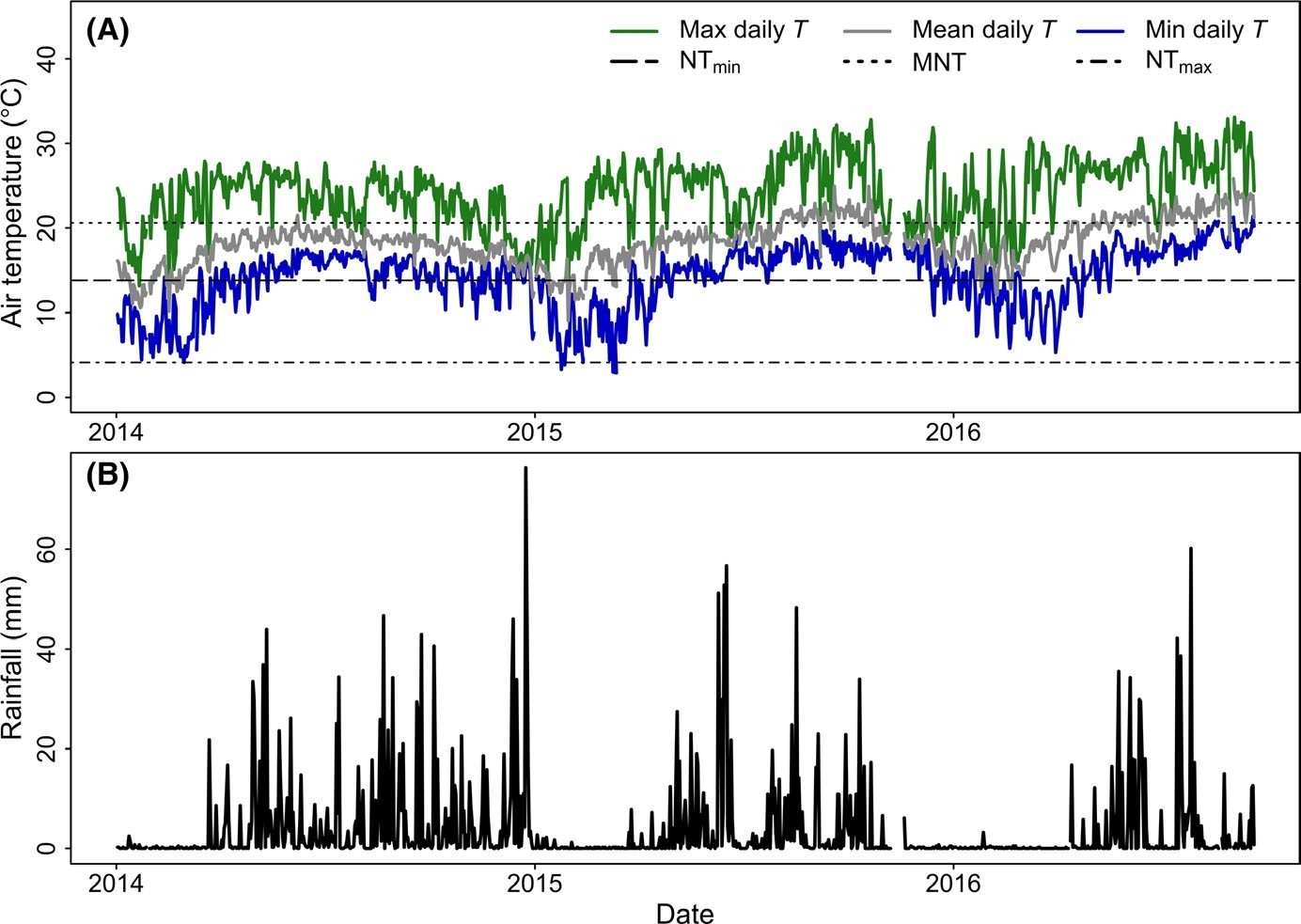Respiratory temperature responses of tropical conifers differ with leaf morphology
08.09.2021 -
Respiratory temperature responses of tropical conifers differ with leaf morphology
Stephanie C. Schmiege, Brendan M. Buckley, Dennis W. Stevenson, Mary A. Heskel, Truong Quang Cuong, Le Canh Nam, Kevin L. Griffin
Department of Ecology, Evolution and Environmental Biology, Columbia University, New York, NY, USA; 2New York Botanical Garden, Bronx, NY, USA; 3Lamont-Doherty Earth Observatory, Columbia University, Palisades, NY, USA; 4Department of Biology, Macalester College, Saint Paul, MN, USA; 5Bidoup Nui Ba National Park, Lac Duong District, Lam Dong Province, Vietnam; 6Forest Science Institute of Central Highlands and South of Central Vietnam, Dalat City, Lam Dong Province, Vietnam and 7Department of Earth and Environmental Sciences, Columbia University, New York, NY, USA
Abstract
1. Photosynthetic traits suggest that shade tolerance may explain the contrasting success of two conifer taxa, Podocarpaceae and Pinaceae, in tropical forests. Needle-leaved species from Pinus (Pinaceae) are generally absent from tropi- cal forests, whereas Pinus krempfii, a flat-leaved pine, and numerous flat-leaved Podocarpaceae are abundant. Respiration (R) traits may provide additional insight into the drivers of the contrasting success of needle- and flat-leaved conifers in tropical forests.
2. We measured the short-term respiratory temperature (RT) response between 10 and 50°C and foliar morphological traits of three needle- and seven flat-leaved conifer species coexisting in a tropical montane forest in the Central Highlands of Vietnam containing notable conifer diversity. We fit a lognormal polynomial model to each RT curve and extracted the following three parameters: a (basal R), and b and c (together describing the shape of the response).
3.Needle-leaved species (Pinus kesiya, Pinus dalatensis and Dacrydium elatum) had higher rates of area-based R at 25°C (R25-area) as well as higher area-based mod- elled basal respiration (a) than flat-leaved species (P. krempfii, Podocarpus neriifolius, Dacrycarpus imbricatus, Nageia nana, Taxus wallichiana, Keteeleria evelyniana and Fokienia hodginsii). No significant differences were found between needle- and flat-leaved species in mass-based R25 (R25-mass) or in the shape of the RT response (b and c); however, interspecific differences in R25-mass, R at nighttime temperature extremes (R4.1 and R20.6) and leaf traits were apparent.
4. Differences in R25-area and a suggest that needle-leaved foliage may be more en- ergetically costly to maintain than flat-leaved foliage, providing new insight and additional support for the hypothesis that shade tolerance is an important driver
5. Interspecific differences in R25-mass and leaf traits highlight that varying ecological strategies are employed by conifers to coexist and survive in the Central Highlands of Vietnam. Ultimately, these data further our understanding of current conifer biogeographical distributions and underscore the need for additional studies to elucidate the effects of extreme temperature events on the continued survival of conifers in this unique forest.
K E Y WO R D S: conifers, respiration, temperature, tropical montane forests
 FI G U R E 1: Mean, maximum and minimum daily temperature (T; A) and total daily rainfall (B) from the nearest weather station at Giang Ly. The dashed line represents the mean nighttime temperature (MNT; 13.8°C), the dotted line represents the nighttime temperature maximum calculated as the mean maximum nighttime temperature of the warmest 3-day period (NTmax; 20.6°C), and the dot-dashed line represents the nighttime temperature minimum calculated as the mean minimum nighttime temperature of the coldest 3- day period (NTmin; 4.1°C) from the nearby Giang Ly meteorological station 2014– 2016
FI G U R E 1: Mean, maximum and minimum daily temperature (T; A) and total daily rainfall (B) from the nearest weather station at Giang Ly. The dashed line represents the mean nighttime temperature (MNT; 13.8°C), the dotted line represents the nighttime temperature maximum calculated as the mean maximum nighttime temperature of the warmest 3-day period (NTmax; 20.6°C), and the dot-dashed line represents the nighttime temperature minimum calculated as the mean minimum nighttime temperature of the coldest 3- day period (NTmin; 4.1°C) from the nearby Giang Ly meteorological station 2014– 2016
-
Species-Specific Allometric Equations for Predicting Belowground Root Biomass in Plantations: Case Study of Spotted Gums (CORYMBIA citriodora subspecies variegata) in Queensland
16.09.2021 -
Respiratory temperature responses of tropical conifers differ with leaf morphology
08.09.2021 -
Sinh trưởng và ảnh hưởng của các nhân tố sinh thái đến sinh trưởng rừng trồng thông Caribê (Pinus caribaea Morelet) tại Lâm Đồng
07.09.2021 -
Buổi lễ công bố trao quyết định Quyền Viện trưởng Viện Khoa học Lâm nghiệp Nam Trung Bộ và Tây Nguyên
11.08.2021 -
Buổi gặp mặt chia tay và trao quyết định nghỉ hưu.
11.08.2021 -
Ảnh hưởng của chất điều hòa sinh trưởng thưc vật lên hom cành dum tuyết (Rubus niveus) trong điều kiện nhà kính tại Đà Lạt
24.03.2021 -
Field methods for above and belowground biomass estimation in plantation forests
23.03.2021 -
GENETIC DIVERSITY OF NATURALLY DISTRIBUTED Rhododendron moulmainense Hook. f. POPULATIONS IN LAM VIEN PLATEAU, VIETNAM REVEALED BY ISSR AND SCoT MARKERS
11.03.2021
